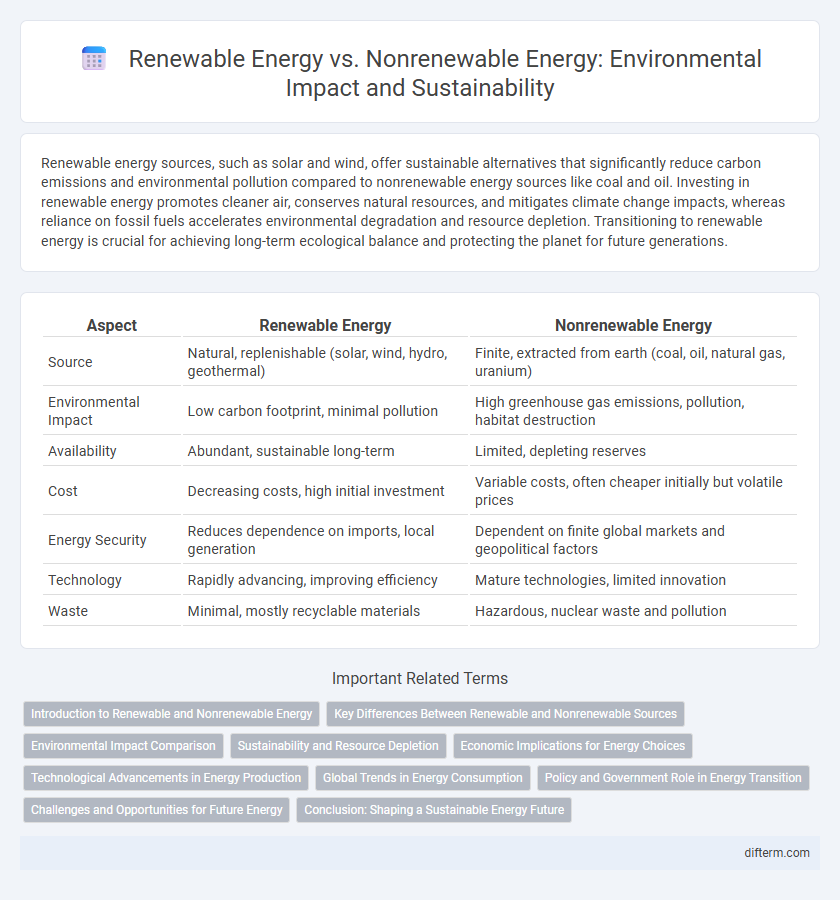Renewable energy sources, such as solar and wind, offer sustainable alternatives that significantly reduce carbon emissions and environmental pollution compared to nonrenewable energy sources like coal and oil. Investing in renewable energy promotes cleaner air, conserves natural resources, and mitigates climate change impacts, whereas reliance on fossil fuels accelerates environmental degradation and resource depletion. Transitioning to renewable energy is crucial for achieving long-term ecological balance and protecting the planet for future generations.
Table of Comparison
| Aspect | Renewable Energy | Nonrenewable Energy |
|---|---|---|
| Source | Natural, replenishable (solar, wind, hydro, geothermal) | Finite, extracted from earth (coal, oil, natural gas, uranium) |
| Environmental Impact | Low carbon footprint, minimal pollution | High greenhouse gas emissions, pollution, habitat destruction |
| Availability | Abundant, sustainable long-term | Limited, depleting reserves |
| Cost | Decreasing costs, high initial investment | Variable costs, often cheaper initially but volatile prices |
| Energy Security | Reduces dependence on imports, local generation | Dependent on finite global markets and geopolitical factors |
| Technology | Rapidly advancing, improving efficiency | Mature technologies, limited innovation |
| Waste | Minimal, mostly recyclable materials | Hazardous, nuclear waste and pollution |
Introduction to Renewable and Nonrenewable Energy
Renewable energy sources, such as solar, wind, and hydro power, provide sustainable alternatives by harnessing natural processes that replenish over time. Nonrenewable energy, including coal, oil, and natural gas, relies on finite fossil fuels that contribute significantly to greenhouse gas emissions and climate change. Transitioning to renewable energy solutions is crucial for reducing environmental impact and ensuring long-term energy security.
Key Differences Between Renewable and Nonrenewable Sources
Renewable energy sources, such as solar, wind, and hydroelectric power, are naturally replenished and produce minimal greenhouse gas emissions, making them sustainable and environmentally friendly. Nonrenewable energy sources, including coal, oil, and natural gas, are finite resources that emit high levels of carbon dioxide and contribute significantly to pollution and climate change. The key differences lie in availability, environmental impact, and long-term sustainability, with renewables offering a cleaner and more reliable energy future.
Environmental Impact Comparison
Renewable energy sources such as solar, wind, and hydroelectric power generate electricity with minimal greenhouse gas emissions, significantly reducing air pollution and mitigating climate change effects. Nonrenewable energy sources, including coal, oil, and natural gas, release high levels of carbon dioxide and other pollutants, contributing to global warming and environmental degradation. Transitioning to renewable energy supports sustainable ecosystems, conserves natural resources, and decreases harmful environmental footprints compared to fossil fuel dependence.
Sustainability and Resource Depletion
Renewable energy sources such as solar, wind, and hydroelectric power offer sustainable solutions by harnessing natural processes that continuously replenish, minimizing environmental impact. Nonrenewable energy resources like coal, oil, and natural gas contribute to rapid resource depletion and long-term ecological damage due to finite reserves and greenhouse gas emissions. Transitioning to renewable energy is essential for maintaining ecological balance and reducing carbon footprints associated with fossil fuel consumption.
Economic Implications for Energy Choices
Renewable energy sources such as solar and wind reduce long-term operational costs due to minimal fuel expenses and lower maintenance requirements, promoting economic sustainability. Nonrenewable energy, including coal and oil, involves fluctuating fuel prices and higher environmental remediation costs, increasing financial risks for economies reliant on them. Investment in renewable infrastructure stimulates job creation and innovation, driving economic growth while mitigating the adverse economic impacts of carbon emissions and climate change.
Technological Advancements in Energy Production
Technological advancements in renewable energy, such as improved solar panel efficiency and wind turbine design, have significantly reduced the cost and increased the scalability of green energy production. Innovations in energy storage systems, including lithium-ion batteries and grid-scale solutions, enhance the reliability and integration of renewable sources into existing power grids. Conversely, nonrenewable energy technologies continue to advance in carbon capture and storage, yet they struggle to match the environmental benefits and long-term sustainability offered by renewable alternatives.
Global Trends in Energy Consumption
Global trends in energy consumption reveal a steady increase in renewable energy adoption, with solar and wind power experiencing exponential growth worldwide. Despite this shift, nonrenewable energy sources such as coal, oil, and natural gas continue to dominate the energy mix, accounting for over 80% of global consumption in 2023. Efforts to reduce carbon emissions and combat climate change are driving significant investments in renewable technologies and energy efficiency improvements across multiple sectors.
Policy and Government Role in Energy Transition
Government policies play a crucial role in accelerating the transition from nonrenewable energy sources like coal and oil to renewable energies such as solar, wind, and hydropower. Regulatory frameworks, subsidies, and tax incentives designed to promote clean energy investments are essential for fostering innovation and reducing carbon emissions. Strategic public investments in renewable infrastructure and stringent environmental standards drive market shifts towards sustainable energy systems, ensuring long-term environmental and economic benefits.
Challenges and Opportunities for Future Energy
Renewable energy sources such as solar, wind, and hydro face challenges including intermittency, high initial investment costs, and the need for advanced grid infrastructure. Nonrenewable energy, primarily fossil fuels like coal, oil, and natural gas, presents opportunities in established technology and existing infrastructure but poses environmental risks such as greenhouse gas emissions and resource depletion. Future energy development requires balancing the scalability of renewable technologies with the reliability of nonrenewable sources while investing in innovation and policy support to enable sustainable energy transitions.
Conclusion: Shaping a Sustainable Energy Future
Renewable energy sources, such as solar, wind, and hydroelectric power, offer a sustainable alternative to finite fossil fuels by reducing greenhouse gas emissions and minimizing environmental degradation. Transitioning to a renewable-based energy grid enhances energy security while mitigating climate change impacts. Investing in innovative technologies and supportive policies is crucial for accelerating the global shift toward a resilient and eco-friendly energy future.
renewable energy vs nonrenewable energy Infographic

 difterm.com
difterm.com